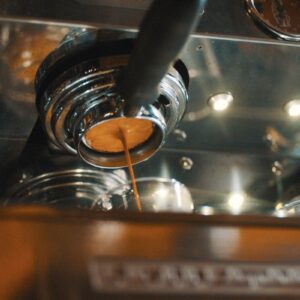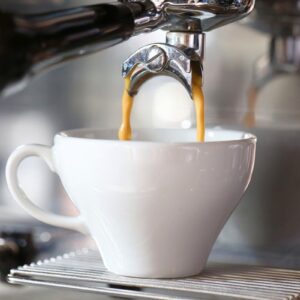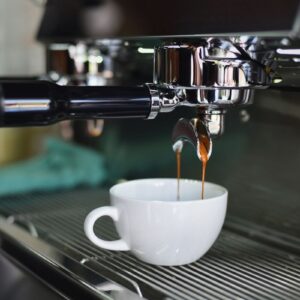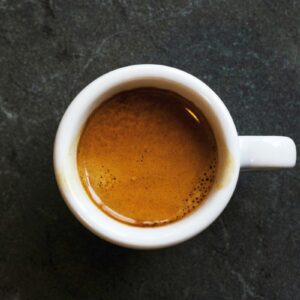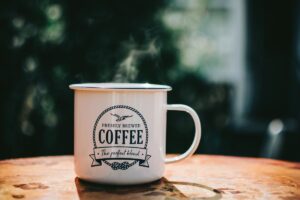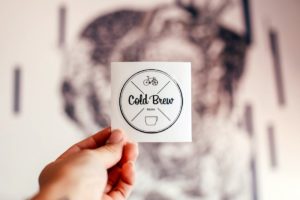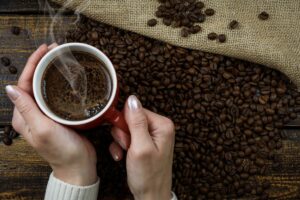How to make better coffee at home?
Chances are that you will drink most of your cups of Joe at home, especially with current prices.
So, why not upscale your experience?
I am here to show you how.
By Jozo Salmanić – Croatian barista with 15 years of experience.
Affiliate disclosure
This page may contain affiliate links – we may earn a small commission when you make a purchase through these links. This is at no extra cost to you.
How To Brew Coffee At Home
Let’s start with the basics. “Brewing is the typical method of preparing roasted coffee beans for drinking.” – The Coffee Wiki.
You need roasted and ground coffee beans, any water-heating method, and your desired coffee maker.
Beans, Beans, The Musical Fruit
We are at the peak of coffee culture, and getting good beans has never been easier.
All you need to do is ensure your beans are top-quality, freshly roasted, and ethically sourced.
I like to buy beans from small roasteries, but I won’t say no to big brands.
Trying different coffee beans is the best thing ever!
My advice is to find a local roastery and connect with them, so you can always have a source of fresh and freshly roasted beans.
Heating The Water
The NCA teaches us that the ideal water temperature for most brewing methods is between 195°F and 205°F.
That’s just a little below the boiling point.
A gooseneck kettle with a built-in thermometer is the easiest way to secure it.
You can heat the water using a stovetop, kettle, or campfire, and then check the temperature with a kitchen thermometer.
Or, you can boil the water, and let it rest for 30-ish seconds, but that’s not the most precise way.
Different coffee brewing methods will call for different water temperatures.
If you can, get a gooseneck kettle with temperature control.
4 Coffee Gear & Coffee Recommendations
- Breville Barista Pro – An excellent manual espresso machine for home use
- Philips 3200 Series Espresso Machine – Easy-to-use fully automatic coffee machine for small office or home use
- Rancilio Egro ONE Touch – High capacity fully automatic commercial coffee machine for professional use
- Koa Coffee – Premium hand-picked Hawaiian coffee. Have you tried American coffee yet?

How To Brew Coffee At Home – Choose Your Coffeemaker
There are many ways to skin a cat, and even more to make coffee at home.
The most popular ones are:
- Drip coffee maker
- Espresso maker
- AeroPress
- French press
- Chemex
- V60
Coffee makers come in all sizes and shapes and can cost from just a few nickels (Vietnamese coffee filter) to five-figure numbers (top-end espresso machines).
Some of them will require electricity, while others are simple tools.
It doesn’t mean any of the coffee makers is better or worse.
They just produce different coffee drinks.
I love making coffee using the same beans in different coffee makers and getting different results.
It just shows how versatile and complex coffee making truly is.
The Importance Of Grinding Before Brewing
If you buy pre-ground coffee, you are denying yourself the true experience of coffee.
You should grind coffee just before brewing.
A top-quality grinder is equally important as your coffee maker.
“Most ground coffee stays fresh for about one week after grinding.” – says this TaylorLane article.
The fresher, the better.
How To Make The Best Coffee At Home – 6 Golden Rules
After years of working as a barista and making coffee at home, I set up 6 golden rules for making the best coffee.
They are universal and applicable to every method, budget, or level of knowledge.
Learn About Your Coffee Beans
Don’t settle for shady coffee – a blend of different and untraceable beans.
Learn where your coffee comes from.
Coffee beans from different parts of the globe have different characteristics.
Single-origin beans are the best beans you can buy for a reasonable price.
Learn where they grow, and how they are washed, treated, and roasted.
Look for a Fair Trade Coffee logo – it means the workers got honest pay.
Every single thing affects your beans.
A Perk Coffee article says: “For those who are seeking a unique experience, single origin coffee is an option for you as no two batches will taste the same.”
How To Make Better Coffee At Home And Why
Making better coffee at home should be your priority.
At home, you can experiment with beans, methods, and equipment.
You can find the best ratio that suits you and even try new things.
When you drink coffee at coffee shops, you have no influence on what the barista will serve you.
It could be the best coffee in the world (highly subjective), but if you don’t like it, you won’t drink it again.
Your home should be your sanctuary from bad-tasting coffee. That’s why I’m going to show you how to make better coffee.
Buy Fresh Beans And Grind Them Just Before The Brewing
Fresh beans are a whole other level of coffee experience.
Every coffee package should have a roasting date, so you can check the freshness of your beans.
Grinding coffee just before brewing preserves the freshness of the beans.
It’s simple – ground coffee has more surface which can be influenced by external factors.
Investing in a decent grinder should also be one of your goals.
Cheap models will only ruin your coffee experience.
Pick a good grinder, and it will last you for decades.
Store Your Coffee Beans In An Airtight Jar
“Coffee is an agricultural product.” – Asser Christensen from Coffee Chronicler reminds us.
Hence, it can get spoiled.
Air, humidity, sunlight, and temperature extremes are an enemy of your beans.
If you have extra bucks to spend, you can buy specialized metal containers to preserve the freshness of your beans. These containers are also the perfect gift for coffee lovers.
Or you can do as I did: buy an airtight glass jar and keep it at room temperature, away from sunlight.
It works the same, but it’s much cheaper.
Don’t freeze your coffee beans, as it will only lead to accumulating extra moisture.

Pay Attention To The Water
“Water plays a dual role in coffee as both solvent and main ingredient.” – as this article from Bloom reminds us.
Use only fresh and clean water for your coffee.
I use bottled water for mine because I found the brand that gives me the best results.
Using tap water is also OK if your tap water is top quality.
Although, I would recommend using Brita filters.
Using distilled water is a no-no. It will give you the blandest cup of coffee you ever tasted.
Clean Your Coffee Maker Regularly
I practice washing my coffee maker (any of them) right after brewing.
If not, the residue will build up and change the taste of the next coffee batch I brew with that maker.
Change it to worse, of course.
All coffee makers are a possible Woodstock for all sorts of bacteria – warmth and organic matter make perfect conditions.
“Most coffee makers are crawling with germs and growing mold.” – Adrianna Rodriguez from USA Today warns us.
Besides washing after use, most coffee makers need regular descaling, especially if tap water is full of minerals.
You can use a white vinegar solution for that.
Remember, there is no such thing as a coffee maker that is too clean.
Use Top-Class Coffee Which Is Within Your Budget
I have never tasted Black Ivory Coffee.
Why? Because a pound of it costs around $1,200.
But I have tasted numerous equally great coffee beans (especially the Kenyan ones!).
Some were extremely pricey, but some cost just a few bucks.
The world of coffee has its fair share of snobs, just like any other subculture.
“Expensive Coffee doesn’t mean better coffee” – Luke Bantata says what most coffee experts know.
Explore the beans within the limits of your budget.
Don’t starve because you bought expensive beans just to put them on Instagram.
How To Grind Coffee That Tastes Good
Grinding the coffee is a process of breaking the coffee beans into smaller bits, so water can extract the flavor.
Extraction lasts longer with the coarse grind because water needs more time to extract the flavor from the larger parts.
And vice versa, finer grind takes less time to extract.
What Grind Size Should You Use For Your Coffee Maker
You cannot use all grind sizes for all coffee makers. And you definitely should not stick to same grind size in all coffee makers, too.
Coffee grind affects coffee taste and flavor, and you can end up with over-extracted or under-extracted coffee if you use the wrong one.
Here is the checklist for all grind sizes.
Extra Coarse Grind Size
This grind size is fit for cowboy coffee and cold brew.
Both coffee making methods require longer extraction, especially the cold brew, which extracts the beans using cold water.
You can still see the shape of the beans, as they are roughly ground.
Coarse Grind Size
I use coarse grind to make coffee using my French press or percolator.
This setting is also used for coffee cuppings.
The beans ground this way will have a texture of sea salt.
Medium-Coarse Grind Size
This is a versatile grind size, as you can use it for all immersion brewers and batch brewers.
I mostly use it for Chemex coffee. The grind resembles rougher sand.
Medium Grind Size
Medium grind resembles regular sand in texture.
This is the golden mean of grinding, as you can use it for almost all methods and adjust your recipes accordingly.
Medium-fine Grind Size
This grind size is needed if you are a fan of pour-over coffee makers and AeroPress.
The texture is pretty gritty.
Fine Grind Size
Fine grind is also known as the espresso grind.
Most pre-ground coffee you buy at supermarkets is ground at this level.
It looks like a slightly finer table salt, and you will use it for Moka pots, espresso machines, and even AeroPress.
Extra-Fine Grind Size
This is the finest grind for making Turkish coffee.
In my childhood, we used classical hand mills to produce this grind.
Most modern coffee mills don’t even have this option.

What Type Of Grinder Do You Need
As you can see, grinding is a crucial part of coffee brewing.
Use the wrong grind size, and you will end up with a cup of dirty water.
That’s why you need a good grinder, to produce a precise and consistent grind.
Here are the three main options:
Blade Grinders
Blade grinders are small machines with a blade attached to the spinning part.
These are often marketed as universal grinders that can handle everything from coffee to spices. They can do it all indeed, but…
Blade grinders will hack and slash your coffee beans, producing an uneven grind.
As a bonus, these grinders overheat the beans.
I never use them for coffee and neither should you, unless it is a coffee emergency.
Flat Burr Grinders
Two parallel adjustable discs rotate to make a consistent grind.
The distance between the discs determines the grind size.
The cheaper models tend to overheat if the workload is heavy.
Conical Burr Grinders
This type of grinder is the one you need.
It has two main parts – a cone and a ring.
Adjusting the ring adjusts the distance between the ring and the cone.
That process determines the grind size.
If you choose a top-quality model, there are no differences between conical and flat burr grinders.
Make Better Coffee At Home With Espresso Maker
Home-line espresso machines are gaining popularity fast.
One of the reasons is the cost of coffee.
According to USDA, in 2022 it cost around 22.7 cents to make a cup of coffee with milk and sugar at home.
How much are you paying for yours in a coffee shop?
But that is just part of the reason.
Small, home-line espresso machines are nowadays as powerful as the large industrial ones.
Making good coffee on these machines takes a certain level of know-how, but it is more rewarding than using bean-to-cup machines.
Here are the rules for making better coffee with an espresso maker.
A Clean Machine Is A Must
Before pulling an espresso shot, ensure your portafilter is clean and dry.
Any leftover water or old coffee ground will make your next espresso taste bitter and burnt.
Rinsing your group head before inserting the portafilter ensures there is no leftover coffee.
It also preheats your group head for even better extraction.
Use Correct Dosage
SCAA states that the correct dosage for espresso is 7 – 9 grams in .85–1.2 ounces of water.
However, in modern coffee times, that means almost nothing.
Nowadays, doses vary from 5 grams to 30 grams, usually between 15 and 20 grams.
That depends on the roast level and the type of beans, so different beans will need different doses.

Distribute The Ground Coffee
“Distribution is the process of preparing the ground coffee before we compress it using a tamp.” – says this article from Seven Miles.
Your coffee grounds need to be distributed evenly in the portafilter’s basket.
Failing to do so will create “tunnels” – spots with lower amounts of coffee.
If that happens, hot water will just run through these tunnels, leading to an under-extracted shot of espresso.
The best thing you can do is use distributor tools like Apexstone, Beymill, and Zaldia.
They will guarantee an even distribution every time.
Proper Tamping For A Perfect Shot
When you distribute your coffee grounds in your portafilter, you need to press them, so no air pockets are left inside.
That’s why you need a tamper.
Tamper is “a tiny tool that is used to pack (or “tamp”) espresso grounds into the basket of an espresso machine.” – says this article from Something’s Brewing.
Put the hip of the portafilter on the counter or any other flat and hard surface.
Make sure coffee is evenly distributed.
Using the tamper, apply pressure to the portafilter, until you get a sturdy coffee disc.
How much pressure should you apply?
The rule of thumb is around 30 pounds.
Dunno how they measure it, tho.
The only way is trial and error.
The important thing is that you press the coffee grounds evenly, apply just enough pressure and clean all the grounds from the edges of the portafilter.
Do Not Waste Time
There are steps you need to follow to make sure everything goes smoothly.
You clean the portafilter and dry it.
Then you put the coffee inside, distribute it evenly and tamp it.
After that, you rinse the brew head and immediately put the portafilter inside.
It sounds complicated at first, but later, it’s all muscle memory.
Don’t Forget The Wrap-Up Process
Preparation is key to every successful process.
After brewing your espresso, empty the basket, clean it and dry it.
Rinse the group head, put the portafilter inside, and you are ready for a new shot of espresso.
Cleaning everything immediately after brewing creates a healthy habit.
That way, you will be sure your espresso machine is clean, without leftover residue.
Besides improving the taste of your espresso, cleaning also prolongs the lifespan of your coffee maker.

How To Make Drip Coffee Taste Better?
Drip coffee in a diner, accompanied by an apple pie, that’s the USA in the 60s and 70s.
Dark times for coffee lovers.
Most people just wanted their caffeine fix, disregarding the taste.
However, drip coffee is still a superb method, and I have a few tricks to make it even better.
Buy Only Whole, Fresh, And Top Quality Beans
You can’t expect a great coffee taste if you use pre-ground coffee.
Sure, the taste can be good, but buying fresh beans and grinding them before brewing takes your coffee experience to another level.
Use Medium Grind For Your Drip Coffee Maker
Medium grind works the best, especially freshly ground coffee.
You can dance between medium-coarse and medium-fine, but do not go any lower or higher on the grind scale.
Use Bottled Water For Brewing
Water makes up to 99% of any coffee drink, including your favorite drip coffee.
If your tap water tastes funny, use bottled water.
That way, your coffee will taste as it should, without chlorine or mineral content.
Cleanliness Is Next To Godliness
Coffee makers can be surprisingly dirty, as this NSF study shows us.
You should wash your drip coffee maker thoroughly as soon as you finish brewing.
That prevents the buildup and bacteria, which change the taste of your coffee and pose a health hazard.
Need more advice on how to clean your coffee maker?
We have five great tips.
Can’t Stand The Heat
The carafe of your pour-over machine stands on a hot plate.
To prevent over-extraction, turn the heat off as soon as your coffee is brewed.
If your carafe is not heat insulated, remove it from the hot plate.
How To Make Good Coffee At Home Without A Machine
You can make good coffee even without the machine.
Here is how you can get your caffeine fix if you don’t have any machinery, just ground coffee, and a heat source.
Cold brew coffee is left out of this list, because you should “let the brew sit in the fridge for 18 to 24 hours before straining.” – Megan Splawn wrote for The Kitchn.
How To Make Cowboy Coffee
Cowboy coffee is best enjoyed on a camping trip.
You don’t even have to grind the beans – just hit them with a hammer or anything heavy to break them into a few bits.
Boil two cups of water in a pot or a saucepan.
After the water boils, add around two spoons of ground coffee.
Put the pot away from heat and cover it.
Check it after five minutes.
If all coffee grounds fell to the bottom, your cowboy coffee is ready to be served.

How To Make A Coffee Bag
This method is good if you do have some paper filters lying around.
Fill them with a spoon of your favorite ground coffee and tie the top with a string to make a bag.
If you have tea bags, even better.
Gently replace the tea with coffee.
Pour hot (not boiling!) water into your cup, and just pop your DIY coffee bag inside.
Let it steep for around 3 minutes.
How To Make A Coffee Filter For Pour-Over
Do you want a pour-over coffee, but don’t have the brewer or filters?
All you need is a large cup and a piece of fabric.
Cheesecloth or a handkerchief is your best choice, but any cotton fabric should do.
One of my Colombian friends stated that they sometimes use a clean sock or a T-shirt for this purpose.
Desperate times call for desperate measures.
Put your fabric into the large mug to form a conical shape. Use clips or any means necessary to attach the fabric to the mug.
After that, put your medium-grind coffee into the filter and pour hot water.
How To Make A Primitive French Press Coffee
No glassblowing this time, sorry.
This method replicates the taste, not the coffee maker.
Put the desired amount of coarsely ground coffee in your cup. Put enough hot water to cover the coffee and let it bloom for 30 seconds.
After that, pour the rest of the water inside and let it rest for four minutes.
After four minutes, pour that coffee into another cup, while holding the coffee grounds and not allowing them to pass.
You can use a spoon, strainer, or a piece of cloth.
Healthy Ways To Make Coffee Taste Better
Black, without milk and sugar, is coffee in its purest and healthiest form.
It tastes as coffee should, and it has almost zero calories. However, not everybody likes the taste.
You can change the taste without adding creamers, sweeteners, or sugar syrups.
Here are the things you can add to your jamoke.
How To Make Better Tasting Coffee Using Plant Milk
Plant-based milk is the perfect solution if regular coffee has a too strong taste, but you can’t or don’t want to drink milk or cream.
The most popular plant-based milk types that go well with coffee are:
- Oat milk (my favorite)
- Cashew milk
- Macadamia milk
- Coconut milk
Not all plant-based milk is an ideal choice to add to your coffee.
Some will ruin the experience (looking at you, hemp milk!).
Also, plant-based kinds of milk can be difficult to steam and make latte foam.
However, you can always buy the Barista edition of the most popular milk brands.
The Barista edition milk is easier to use, and it can create the tastiest cappuccinos and lattes, almost without any difference from cow milk.
Sugar Alternatives
Can’t live without sugar, but you could live without extra calories?
Use some of the alternatives:
- Stevia
- Agave nectar
- Maple syrup
- Honey
“Stevia is hundreds of times sweeter than sugar and has no calories.” – states this article from Consumer Reports.
That makes stevia one of the most popular choices.
Agave nectar and maple syrup are perfect if you buy them natural and organic.
The market is full of not-so-healthy knockoffs, which are full of sugar. Buyer beware.
Honey is perfect for sweetening, be it a cake, tea, or coffee. Just buy organic honey with a neutral taste.

How To Make (The) Best Coffee At Home Using Spices
Adding spices to your coffee is not a new trend.
People have done it for centuries. Here are the best choices:
- Vanilla
- Nutmeg
- Cinnamon
- Cocoa nibs
- Star anis
You can always buy premade spice mixes, but just watch out for the ingredients, because some contain high amounts of sugar.
Also, you can give new life to your not-so-fresh coffee grounds by adding spices before brewing.
A Pinch Of Salt
A little bit of salt can bring out the hidden sweetness of the coffee beans.
It also works well if your coffee is bitter.
A pinch, not more.
Add Some Good Fat
Add butter or coconut oil to your coffee to make a super drink, known as bulletproof coffee.
You will need a blender, and some mental strength to try the first sip.
It tastes great, I promise.
How To Make Coffee Taste Good? 3 Helpful Reddit Threads
People sometimes perceive Reddit as a place for conspiracy theories, weebs, and memes of debatable quality.
Although these things exist there (and everywhere else on the internet), Reddit is also a place full of experts, hobbyists, and people who want to brew and drink better-tasting coffee.
Here are some of the Reddit threads that are highly useful – and sometimes funny:
How to make a latte that tastes like Starbucks? – Don’t ask why.
Why does my coffee taste better the cooler it gets? – why, really?
The Daily Coffee Question Thread – ask any question, and the coffee community will answer.
Not every piece of advice from Reddit has to be true. However, you can get your answers and join the community of fellow coffee aficionados.
Photos by JillWellington, Virvoreanu-Laurentiu, Vlada Karpovic, Sharizam, Timi Keszthelyi, StockSnaps and kissevelin


